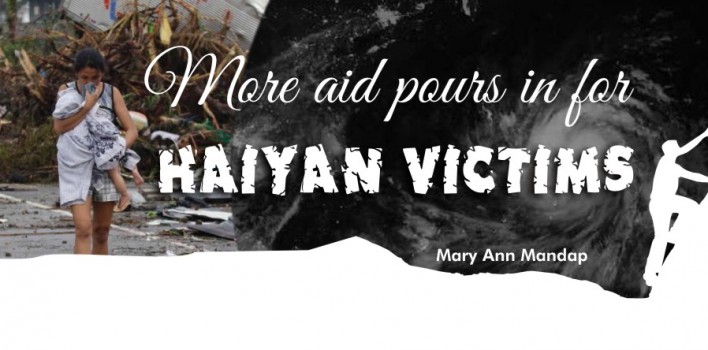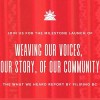More aid pours in for Haiyan victims by Mary-Ann Mandap
 Humanitarian aid poured in from both local and international communities who rallied to help when Typhoon Haiyan, (locally known as “Yolanda”) one of the world’s strongest typhoons on record, struck the Philippines in November leaving widespread death and destruction in its wake.
Humanitarian aid poured in from both local and international communities who rallied to help when Typhoon Haiyan, (locally known as “Yolanda”) one of the world’s strongest typhoons on record, struck the Philippines in November leaving widespread death and destruction in its wake.
At least 9.7 million people in 41 provinces were affected by the disaster, killing nearly 6,000 people and wiping out entire towns. According to media reports, tens of thousands of survivors were left pleading for food, water and medicine.
Meanwhile, President Aquino said the disaster cost nearly $13 billion in damage as the Philippine government released a report detailing a rebuilding plan to restore normalcy in the ravaged areas and help the country to better prepare for survive future storms. He estimated the entire restoration effort to take up to four years.
The Yolanda recovery and reconstruction will require a total of $15.162 billion (P361 billion) in investments, data from the National Economic and Development Authority (NEDA) showed. This amount is programmed to be disbursed over four years, in line with a phased, cumulative and flexible implementation of the Reconstruction Assistance on Yolanda (RAY) Plan.
“The estimated total investment requirements for recovery and reconstruction shall cover shelter and resettlement (P183.3 B), public infrastructure (P28.4 B), education and health services (P37.4 B), agriculture (P18.7 B), industry and services (P70.6 B), local government (P4 B) and social protection (P18.4B),” Economic Planning Secretary Arsenio M. Balisacan said.
“The government has allocated about P34B for the critical immediate actions, which are now underway. Another P100 billion is forthcoming in 2014,” he added.
Meanwhile, to promote transparency, all international aid received for the victims of typhoon Yolanda are posted in a government website dubbed as FAiTh or the Foreign Aid Transparency Hub. Latest data show FAiTH posted a total of P23.798 billion or $538.978 million in pledged assistance.
The Canadian government committed $40.157 million to the aid effort, according to FAiTh. The federal government initially pledged Cdn $10 million in direct assistance, then upped the ante to Cdn $25 million as the extent of destruction became more pronounced.
On top of that, Canada came up with a matching mechanism for donations made by individual Canadians to registered Canadian charities supporting the Haiyan relief effort. “Time and time again, Canadians have demonstrated they are among the most compassionate and generous people in the world. Our government is making sure their contributions can do more to ease pain and suffering,” said Christian Paradis, Minister of International Development.
Canada likewise deployed its first responders, such as the Disaster Assistance and Response Team (DART) and the Canadian Medical Assistance Teams (CMAT), and sent a Royal Canadian Air Force aircraft to help in relief operations.
As part of its humanitarian assistance, Canada also prioritized the processing of immigration applications by those significantly and personally affected by Typhoon Yolanda. In a statement, Canada Citizenship and Immigration Minister Chris Alexander said, “our government will continue to take action to support those impacted by the storm and we will work with our partners to ensure that urgent support is provided to those who are significantly affected by this tragic event.”
Celebrities did their share. Among them was pop superstar Justin Bieber, who flew to the disaster zone to bring hope to survivors. He sang Christmas carols, played basketball, hugged kids and gamely posed for pictures. The teen heartthrob earlier posted a message on Twitter urging his 46 million followers to donate to typhoon victims.
In British Columbia, the provincial government set up a similar matching program for donations made by B.C. residents. B.C. Premier Christy Clark announced that her government would match Haiyan donations to the Canadian Red Cross and other charities up to $300,000.
Community effort
The tragedy seemed to bring out the best in the Filipino overseas community as well. Many groups and associations came together to mount ingenious fund-raising campaigns to raise money and donations of goods for the relief effort.
Dahong Pilipino rounded up a number of fundraisers in Metro Vancouver. There were telethons, concerts, cultural shows, an early-morning walkathon, dinner-dances, a bowling tournament, charity photo shoots, and cocktails attended by Vancouver’s crème de la crème. Several business establishments became instant drop-off points for clothing, canned goods and cash donations, while churches called on their faithful to donate generously to the victims as Archbishop J. Michael Miller designated two Sunday second collections to help the typhoon victims.
In schools, students, teachers and parents came up with novel ways to chip in, such as bake and Santa sales and drop boxes, as Vancouverites became more aware of the damage and destruction wreaked by the super storm.
From individuals and community groups alone, at least Cdn $600,000 has been raised for the relief effort. With both federal and provincial matching, the amount could go up to well over Cdn $1.5 million, according to estimates from the Philippine Consulate General in Vancouver.
As Premier Christy Clark said, “the entire country has a difficult time ahead, as authorities struggle to assess the full extent of casualties and damage, and tend to those left homeless.
Our prayers go out to the victims, all those British Columbians with family and friends in the storm’s path, and everyone else in the country as they cope.”
 Canada
Canada







